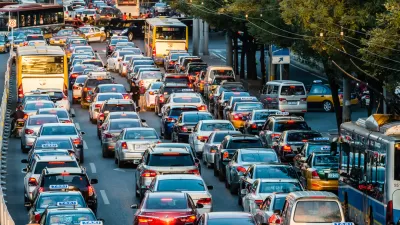Delhi’s unpleasant pollution predicament, and its ensuing health consequences, are causing environmentalists, doctors and local officials to grow increasingly alarmed.
Delhi’s unyielding pollution problems came to the forefront last month, “[w]hen an acrid blanket of gray smog settled over” the city, writes Niharika Mandhana. Environmentalists became concerned and state officials baffled as they sought to better understand “why the air had suddenly gone so bad” she adds. Even doctors are now worried, after seeing sharp increases in visits related to heart and pulmonary matters this winter. Yet despite Delhi’s efforts over the last decade to curb its pollution problem — including closing polluting industries, expanding green spaces, and making costly investments in converting its buses and rickshaws to compressed natural gas — matters seem to be worsening.
Some of the primary factors causing Delhi’s growing pollution and smog include its increasing population, astounding motorization, and lax environmental standards in surrounding areas. “Each day, about 1,400 new vehicles hit the roads of the city, already home to over seven million registered vehicles, a 65 percent jump from 2003” reports Mandhana, adding, “[a]s a result, fine-particle pollution has risen by 47 percent in the last decade. Nitrogen dioxide levels have increased by 57 percent.” Experts such as Anumita Roychowdhury, the executive director of the Center for Science and Environment, asserts that Delhi has “already plucked the low-hanging fruits” in its past policy efforts and that “it’s time for aggressive, second-generation reforms."
Solutions proposed by environmentalists include a heavy tax on diesel vehicles, steep increases in parking charges, and a broad upgrade of the city's public transportation system to ensure greater overall efficiency. Sheila Dikshit, the chief minister of the State of Delhi, denies the gravity of city’s pollution problems, but remains open to new solutions including a “green tax."
“What is alarming is the impact that Delhi’s prosperity and its comfortable living is having on attracting more and more people to come here,” Ms. Dikshit said. “How much we will be able to sustain that impact of people coming and never going out is a big question.”
FULL STORY: ‘Untamed Motorization’ Wraps an Indian City in Smog

Alabama: Trump Terminates Settlements for Black Communities Harmed By Raw Sewage
Trump deemed the landmark civil rights agreement “illegal DEI and environmental justice policy.”

Planetizen Federal Action Tracker
A weekly monitor of how Trump’s orders and actions are impacting planners and planning in America.

Why Should We Subsidize Public Transportation?
Many public transit agencies face financial stress due to rising costs, declining fare revenue, and declining subsidies. Transit advocates must provide a strong business case for increasing public transit funding.

Understanding Road Diets
An explainer from Momentum highlights the advantages of reducing vehicle lanes in favor of more bike, transit, and pedestrian infrastructure.

New California Law Regulates Warehouse Pollution
A new law tightens building and emissions regulations for large distribution warehouses to mitigate air pollution and traffic in surrounding communities.

Phoenix Announces Opening Date for Light Rail Extension
The South Central extension will connect South Phoenix to downtown and other major hubs starting on June 7.
Urban Design for Planners 1: Software Tools
This six-course series explores essential urban design concepts using open source software and equips planners with the tools they need to participate fully in the urban design process.
Planning for Universal Design
Learn the tools for implementing Universal Design in planning regulations.
Caltrans
Smith Gee Studio
Institute for Housing and Urban Development Studies (IHS)
City of Grandview
Harvard GSD Executive Education
Toledo-Lucas County Plan Commissions
Salt Lake City
NYU Wagner Graduate School of Public Service




























